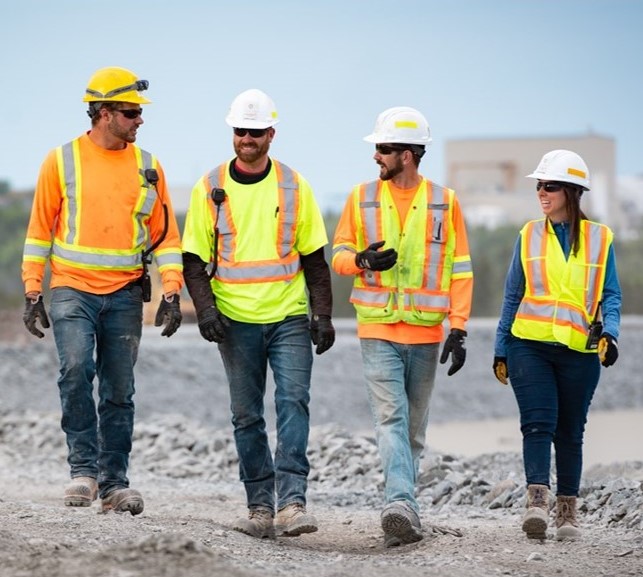
Permitting Case Study
Problems with Nova Scotia’s permitting system have cost the province hundreds of jobs and hundreds of millions of dollars in investment – all from just one company. Here is a case study in why Nova Scotia needs to reform its permitting system for new mines.
According to the International Energy Agency, it takes an average of 17 years to get from mineral deposit discovery to actual mining. Regulatory permitting of new mines is a major bottleneck in the process and jurisdictions across Canada and around the world are taking steps to to cut red tape while maintaining the highest environmental standards.
St Barbara Ltd.’s experience in Nova Scotia illustrates why our provincial government needs to do the same.
St Barbara bought Atlantic Gold in 2019 for $722 million. The deal included the then-extracting Touquoy gold mine, three other planned mines and numerous exploration projects.
Since then, the company has effectively written off most of its investment in Nova Scotia. It has been forced to lay off most of its Nova Scotian staff, indefinitely paused its plans to open new mines, taken the Government of Nova Scotia to court over its poor regulation, and announced that it is divesting its Nova Scotian assets.
St Barbara’s Managing Director and CEO Andrew Strelein recently discussed the company’s experience with Nova Scotia’s permitting system on the Insights podcast with Don Mills and David Campbell: “When you look at the time delays and the lack of certainty over permitting, we wrote down, as you said, a significant portion, over half a billion dollars of our $700 million investment.
“None of these projects were able to be permitted in the timelines that we had anticipated….In particular, the repeated delays in the permitting of additional tailings storage capacity at Touquoy really meant that the whole integrated development plan became unviable. That became the critical issue of delay and not being able to advance the projects.
“They [the government] never actually said ‘no.’ It was just a rinse and repeat process of asking for more and more information. We got to the point though where the delays had been such that really the entire integrated development plan was no longer able to be executed and no longer viable…We had to close Touquoy early and so that’s when about 300 jobs or more were lost at the time.”
Strelein particularly highlighted the challenge of working with Nova Scotia’s Department of Environment and Climate Change: “Our view was that the Nova Scotia Environment and Climate Change Department would not carry out a fair and science-based assessment of any project proposal we put forward. The provincial government has been supportive and communities supportive, but we were encountering difficulties in the department.”
Environment “just doesn’t work in a timely and transparent manner…There are a number of NSECC officers who are resistant to accept industry-leading expert recommendations. When we make proposals, we get independent expert advice to guide us and come up with recommendations. But what we find is people that don’t have the expertise that we’re talking about in these areas [are] not accepting industry expertise, making their own assessments and substitution of that….”
NSECC has declined the company’s offers to pay the cost of the Department hiring its own independent experts.
Strelein also said of NSECC, “They are also unwilling to use the expertise available with the DNRR [Department of Natural Resources]. You’ve got mining expertise available in the Department of Natural Resources. So that’s been a key problem for us with lack of timeliness and independent expert advice being rejected by people who often aren’t in a place to question that sort of expertise.”
Strelein repeatedly stressed the need for industry and government to work collaboratively – to protect the environment while also taking advantage of Nova Scotia’s economic opportunities.
St Barbara’s Nova Scotia projects still have tremendous economic potential. Hopefully a new owner can start with a clean slate and find a more receptive partner in the provincial government.
St Barbara’s Touquoy mine in Moose River, which extracted from 2017-23, is the sort of economic development Nova Scotia needs more of.
The mine created over 300 direct jobs and over 900 spinoff jobs. The average salary at the mine was $84,000 per year. It generated $7.4 million in provincial tax revenue, $3.7 million in municipal tax revenue, and $100 million in economic spinoffs to local businesses. It paid $8.8 million in mineral royalties. The company donated $1.6 million to community and non-profit organizations.
Environmentally, the mine is an excellent example of how modern mining is completely different from what it was historically.
The mine has the largest reclamation bond in Nova Scotia: $80 million. Before getting operating permits today, mining companies must get government approval of reclamation plans and post reclamation bonds (money in escrow, basically) that ensure funds are available to properly take care of sites. In fact, reclamation is a key part of the mining process today and reclamation work at Touquoy is ongoing.
The mine remediated two historical mine sites and 61,000 tonnes of contaminated soil from past operations by digging them up and moving them into the modern mine’s tailings facility, where they can no longer interact with the environment.
96% of the water the mine used was recycled on-site, minimizing the amount it had to draw from local water sources.
Strelein’s full interview on Insights can be heard at https://share.transistor.fm/s/f43d8a67 or on streaming services such as Spotify and Apple Podcasts.



